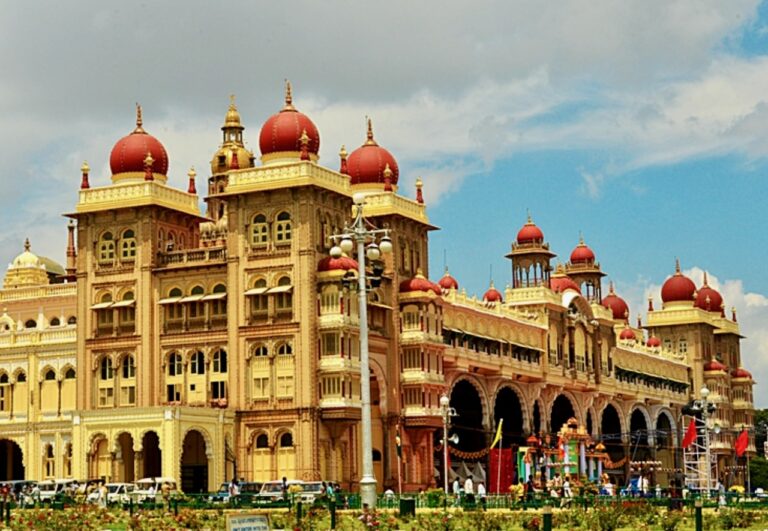Someone (I forget whom) once wrote: “The great dynasties of the world are like the passing summer clouds; they are forever changing and never the same.”
What I found so interesting with the story of Mysore is that its royal dynasty, of enormous wealth, went through transforming times through the centuries and yet always managed to stay in power, with only one interlude. In the middle of the 18th century, a clever Muslim commander-in-chief fooled the king of Mysore into a bizarre and underhand takeover which lasted some 60 years. Fortunately, he had his power eventually reinstated by the British Raj, but only as a princely state.
Mysore was the siege of the Wadiyar dynasty, who ruled the southern state of Kerala, from the late 1300s until 1950.
Srirangapatna, which lies only 15km north of Mysore, was the siege of the Rangaraya dynasty, that ruled another important but different part of southern India. It is on a rocky island, at the confluence of two large rivers, which gave it natural protection from military attacks.
Both Kingdoms, of Hindu persuasion, lived more or less peacefully side by side. Then, in the 14th century, they both became part of the Vijaynagar empire (in Hampi, 400km up north – which I will cover in a later post). They served as vassal states during Vijaynagar’s 200 year existence (14th-16th centuries). Until, a coalition of sultanas from the north of India comprehensively defeated it in 1565, resulting in a major reshuffle between the surviving vassal kingdoms.
Then, despite the many centuries of peaceful cohabitation, the King of Mysore decided to take over the kingdom of Srirangapatna, to add to his own.
About 150 years later, in 1760, a bizarre bloodless hiatus occurred. The commander-in-chief of the Mysore army, Hyder Ali, a Muslim, cleverly wrested power from the Wadiyar king, under the guise of a charade, while masquerading and paying him due deference. He promoted Srirangapatna as the new capital, vaunting its natural strategic defence position against potential enemies. When he died, his son Tipu ended the charade and simply declared himself king. He then proceeded to aggressively enlarge his kingdom, by waging wars with many of his neighbours, among which happened to be the colonising British army. Well, that was a big mistake. The 4 Anglo-Mysore wars that ensued between the British on one side, the sultan’s army, supported by the French, on the other, were bloody affairs. The fourth and final British assault in 1799 was the death knell of the Sultanas. After a long siege of Tipu’s Srirangapatna Fort in 1799, the British defeated and killed him. They then razed the fort to the ground, and the city of Srirangapatna, which had become one of the largest cities in the world, with a population close to 150,000, faded into oblivion. Tipu’s wooden Summer palace did, however, survive. As for the Wadiyars, the British re-established their rule in Mysore, but degraded their kingdom, as I already said, into a princely state.
The Mysore Palace is the second-most-visited sight in India (after the Taj Mahal), and is among the very grandest of India’s royal buildings. It gives an idea of the megalomania of the maharajas of former times. They built the original wooden palace in 1897, but fire destroyed it. They then rebuilt it into a lavish blend of Hindu, mogholian, gothic and Victorian architectural styles – a kaleidoscope of stained glass, teak wood carvings, solid silver doors, inlaid marble with precious stones, gaudy colours, and so on. Undoubtedly over the top. I have seen nothing like it anywhere else in the world.
Every Sunday, they illuminate the palace by switching on 100,000 bulbs laid out over the whole of its facade and parts of its outside parade hall for one hour. Quite a sight.
I also went to visit Tipu’s Summer Palace at Srirangapatna. An entirely wooden complex, with some magnificent wooden panelled paintings going back to the 17th century, and very well preserved, despite being made of natural vegetal based colours. Tipu and his family were interred at a mausoleum about 2km away. The doors are encrusted with lovely, intricate ivory decorations. As for the Fort, well, there isn’t much left of it after the British dismantled it.
Back at Mysore, the Devaraja market, which goes back to Tipu Sultan’s reign, is a huge and vivacious covered bazaar. Local traders sell traditional flower garlands, incense, spices and conical piles of Kumkum (coloured powder used for bindi dots). It also has a large fruit and vegetable section.
My guide and driver insisted one early morning to take me to a local cafe where they served the famous Mysore dish: the ‘masala dosa’, renown throughout India. Despite having to eat with the right hand, I found this rice crepe with potato curry inside to be delicious. When my guide found out my age, he was so surprised that he insisted in inviting me for lunch at his house, so his family could bear witness. Even though I had to eat yet again with the hand (they did not have any cutlery), I must admit I was touched by the gesture and hospitality of this man and his family.
Even though it only has 1.3 million people, Mysore is a bustling city. With a well-educated workforce, the influence of a growing middle class is now being felt throughout the city, though it still very much feels like an old ‘medieval’ town but with blaring neon lit brands.

